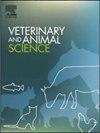Impact of adding wheat and poultry by-product meal to the diet on broiler carcass traits, production performance, and physical pellet quality
IF 1.9
Q2 AGRICULTURE, DAIRY & ANIMAL SCIENCE
引用次数: 0
Abstract
A total of 450, one-day-old broiler chicks (Ross 308) were used to examine the impact of three poultry by-product meal (PMB) levels (0, 2, and 4 %), and three wheat levels (0, 10, and 20 %) on physical pellet quality (PPQ), growth performance, and carcass features of broilers during starter, grower and finisher periods. The results of the current study demonstrated that during the starter phase, the inclusion of 2 % and 4 % PBM significantly (P ˂ 0.01) reduced PDI (Pellet Durability Index) in wheat-free diets. However, this reduction was not observed in diets supplemented with 10 % and 20 % wheat. During the growth phase, the inclusion of 2 % and 4 % PBM resulted in a reduction (P ˂ 0.01) in PDI in wheat-free diets. In contrast, diets containing 20 % wheat showed an increase in PDI by adding 2 % and 4 % PBM. During the finisher phase, including of 4 % PBM led to an increase (P ˂ 0.01) in PDI in wheat-free diets. Conversely, in diets containing 10 % and 20 % wheat, PDI decreased by adding 4 % PBM. In the starter diet, includingwheat resulted in a reduction (P ˂ 0.05) in pellet hardness. Additionally, during the growth and finisher phases, the inclusion of 2 % PBM reduced (P ˂ 0.01) PDI in wheat-free diets and diets containing 10 % wheat, respectively; however, this effect was not observed in diets containing 20 % wheat. Feed intake was influenced by the interaction effects of PBM and wheat levels, such that the addition of 10 % wheat to the diet without PBM led to an increase in feed intake compared to diets without wheat and with 0 % or 2 % PBM during the entire period of study (P < 0.05). Throughout the experimental period, no significant differences were observed in the average daily gain among the experimental groups (P ˃ 0.05). Additionally, the feed conversion ratio (FCR) in birds fed diets containing 2 % PBM showed improvement compared to those fed diets with 4 % PBM and was comparable to the control group (P < 0.05). Birds fed 20 % wheat had significantly (P < 0.05) the lowest abdominal fat. The findings of this study indicated that while the inclusion of 2 % PBM improved the FCR in broilers, it resulted in a decrease in PDI during both the starter and growth periods, as well as reduced pellet hardness in the growth phase for diets without wheat.
饲粮中添加小麦和家禽副产物粕对肉鸡胴体性状、生产性能和物理颗粒质量的影响
采用450只1日龄肉鸡(Ross 308),研究了3种家禽副产物粕(PMB)水平(0、2和4%)和3种小麦水平(0、10和20%)对肉仔鸡在发酵期、生长期和育肥期物理颗粒质量(PPQ)、生长性能和胴体特征的影响。本研究结果表明,在起始阶段,添加2%和4% PBM显著(P小于0.01)降低了无小麦日粮中的PDI(颗粒耐久性指数)。然而,在添加10%和20%小麦的饮食中没有观察到这种减少。在生长阶段,添加2%和4% PBM导致无小麦日粮中PDI降低(P小于0.01)。相比之下,在小麦含量为20%的饲粮中,添加2%和4%的PBM可提高PDI。在育肥期,添加4% PBM导致无小麦日粮PDI升高(P小于0.01)。相反,在小麦含量为10%和20%的饲粮中,添加4%的PBM可降低PDI。在起始日粮中,添加小麦导致颗粒硬度降低(P小于0.05)。此外,在生长期和育肥期,添加2% PBM分别降低了无小麦饲粮和含10%小麦饲粮的PDI (P小于0.01);然而,在含20%小麦的日粮中没有观察到这种效应。采食量受PBM和小麦水平的交互作用影响,在整个研究期间,与不含小麦和PBM含量为0%或2%的饲粮相比,在不含PBM的饲粮中添加10%的小麦会导致采食量增加(P <;0.05)。试验期各试验组平均日增重差异无统计学意义(P > 0.05)。此外,饲粮中添加2% PBM的鸟类的饲料转化率(FCR)比饲粮中添加4% PBM的鸟类有所提高,与对照组相当(P <;0.05)。饲粮20%小麦的雏鸟(P <;0.05)的最低腹部脂肪。本研究结果表明,在不添加小麦的饲粮中,添加2% PBM虽然提高了肉仔鸡的FCR,但降低了发育期和生长期的PDI,并降低了生长期的颗粒硬度。
本文章由计算机程序翻译,如有差异,请以英文原文为准。
求助全文
约1分钟内获得全文
求助全文
来源期刊

Veterinary and Animal Science
Veterinary-Veterinary (all)
CiteScore
3.50
自引率
0.00%
发文量
43
审稿时长
47 days
 求助内容:
求助内容: 应助结果提醒方式:
应助结果提醒方式:


